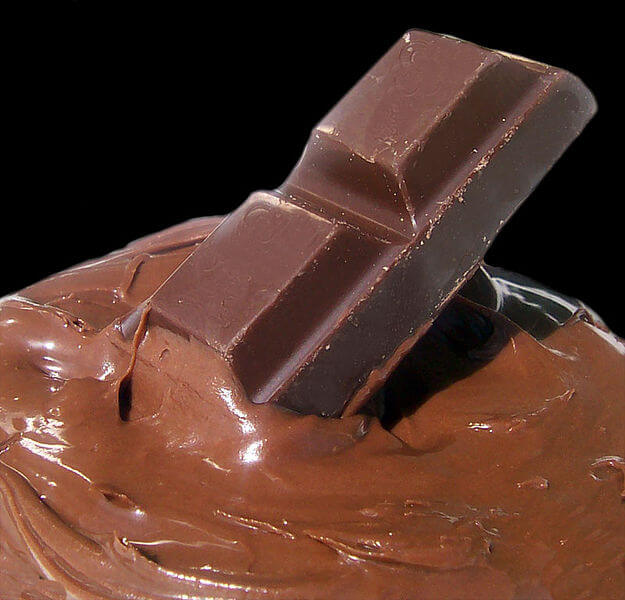The aroma of roasted cocoa beans, a key ingredient for chocolate, emerges from materials that separately emit odors such as fried meat, roast meat, peaches, beef fat, cooked cabbage, human sweat, dirt, cucumber, honey and more

The aroma of roasted cocoa beans, a key ingredient for chocolate, emerges from materials that separately emit odors such as fried foods, roast meat, peaches, beef fat, cooked cabbage, human sweat, dirt, cucumber, honey, and more.
These are some of the discoveries made from a scientific effort to identify the essential aroma and flavor components of the world's most beloved culinary treat, chocolate, as reported at the 242nd Annual Meeting of the American Chemical Society. The research, which documents the flavorings obtained from the processing of cocoa beans, could lead to a new generation of chocolate products with tastes and aromas that we did not know before, according to the words of Dr. Peter Schieberle.
"In order to develop better chocolate, you must know the chemistry behind the flavoring and smelling substances in cocoa and other substances," explains the researcher. "This understanding must start from the flavors in the raw cocoa beans, exist throughout all stages of their processing and continue to the point where the consumer enjoys the chocolate. "When you put chocolate in your mouth, a chemical reaction occurs," explains the researcher. "Some people just bite and swallow the chocolate. If you do that, the reaction doesn't have enough time to occur, and you might lose a lot of the flavor."
Chocolate is made from cocoa beans, which are the seeds of cocoa trees. Raw cocoa beans have a bitter and strong taste and must be processed in order to bring out their characteristic flavors. Processing begins through fermentation, when the moist seeds remain for many days in baskets covered with banana leaves while yeast and bacteria develop with the beans and change their nature. In the next step, the beans are dried in the sun and then roasted. Most of the chocolate used in baking, ice cream and hot liquid chocolate goes through what is known as "Dutch processing", which gives it a milder taste. On a global level, about three million tons of chocolate are produced every year.
Cocoa production developed over the years by trial and error, rather than by scientific analysis, so substances that give chocolate its more refined flavors were unknown, says the researcher, who is a professor at the Institute of Food Chemistry at the University of Munich, Germany. Over the past 20 years, his research team has uncovered many secrets about chocolate's appeal.
The distinct taste of chocolate develops throughout its production. During fermentation, odorless and tasteless substances are formed and these react during subsequent roasting to create odor and taste compounds. The tastes of chocolate and other foods do not only come from the taste buds found in the mouth, the researcher points out. Olfactory receptors present in the nose play an important role in perceiving the concept of smell. The team of researchers identified several odorants found in the cocoa beans and which bind to the smell receptors in the nose. They imitated the general taste of chocolate by combining these separate ingredients and showed that professional tasters were unable to differentiate between these compositions - the taste of the original chocolate versus the taste of the collection of ingredients. When these ingredients were separate, they smelled like fried foods, peaches, cooked meat, and other substances not at all close to chocolate.
"To create a successful aroma of cocoa, only 25 of the 600 volatile compounds found in the beans are required," said the lead researcher. "We call sensing research on this scale "sensomics". This field includes gathering the profile of the main chemical substances responsible for certain foods to have a distinct smell and taste. Since no single compound was identified as solely responsible for the characteristic aroma of cocoa, the researchers were forced to separate the various odors and combine them again in different compositions for testing by professional tasters. This is a crucial step in the pathway to determine the way in which fragrances work together and stimulate the smell and taste receptors in a person in order to create, at the end of the process, the brain's awareness of the food known as chocolate.
Some researchers also discovered a way to improve the taste of chocolate. They found that by adding a little sugar to the cocoa, before it goes through its Dutch processing, the chocolate becomes milder and softer thanks to the formation of flavor components that were unknown before the study. The findings of the research could help the chocolate manufacturers to control the taste of the cocoa products and improve it by referring to the key ingredients found in the mixture.

2 תגובות
The best part is that I just ate chocolate and saw that there was an article about it!
Fascinating article! Thanks.